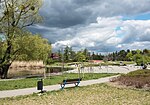The Wola massacre (Polish: Rzeź Woli, lit. 'Wola slaughter') was the systematic killing of between 40,000 and 50,000 Poles in the Wola neighbourhood of the Polish capital city, Warsaw, by the German Wehrmacht and fellow Axis collaborators in the Azerbaijani Legion, as well as the mostly-Russian RONA forces, which took place from 5 to 12 August 1944. The massacre was ordered by Adolf Hitler, who directed to kill "anything that moves" to stop the Warsaw Uprising soon after it began.Tens of thousands of Polish civilians along with captured Home Army resistance fighters were brutally murdered by the Germans in organised mass executions throughout Wola. Whole families, including babies, children and the elderly, were often shot on the spot, but some were killed after torture and sexual assault. Soldiers murdered patients in hospitals, killing them in their beds, as well as the doctors and nurses caring for them. Dead bodies were piled up to be burned by the Verbrennungskommando ("burning detachment") to destroy the evidence of the massacre; though first, dogs were let loose to find survivors to be killed. The operation was led by Erich von dem Bach-Zelewski, though its main perpetrators were the Dirlewanger Brigade and the "RONA" Kaminski Brigade, whose forces committed the cruelest atrocities, drawing criticism from Bach-Zelewski himself.The Germans anticipated that these atrocities would crush the insurrectionists' will to fight and put the uprising to a swift end. However, the ruthless pacification of Wola only stiffened Polish resistance, and it took another two months of heavy fighting for the Germans to regain control of the city.











